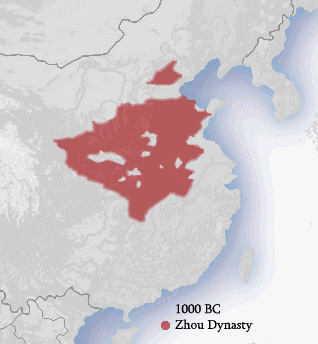Ding may refer to:
Ding may refer to:

The Zhou dynasty was a royal dynasty of China that followed the Shang dynasty. Having lasted 789 years, the Zhou dynasty was the longest dynastic regime in Chinese history. The military control of ancient China by the royal house, surnamed Ji, lasted from 1046 until 771 BC for a period known as the Western Zhou, and the political sphere of influence it created continued well into the Eastern Zhou period for another 500 years. The establishment date of 1046 BC is supported by the Xia–Shang–Zhou Chronology Project and David Pankenier, but David Nivison and Edward L. Shaughnessy date the establishment to 1045 BC.

The Spring and Autumn period was a period in Chinese history from approximately 770 to 481 BCE which corresponds roughly to the first half of the Eastern Zhou period. The period's name derives from the Spring and Autumn Annals, a chronicle of the state of Lu between 722 and 481 BCE, which tradition associates with Confucius. During this period, royal control over the various local polities eroded as regional lords increasingly exercised political autonomy, negotiating their own alliances, waging wars amongst themselves, up to defying the king's court in Luoyi. The gradual Partition of Jin, one of the most powerful states, is generally considered to mark the end of the Spring and Autumn period and the beginning of the Warring States period.

Wang Mang, courtesy name Jujun, was the founder and the only emperor of the short-lived Chinese Xin dynasty. He was originally an official and consort kin of the Han dynasty and later seized the throne in 9 CE. The Han dynasty was restored after his overthrow, and his rule marked the separation between the Western Han dynasty and Eastern Han dynasty. Traditional Chinese historiography viewed Wang as a tyrant and usurper, while more recently, some historians have portrayed him as a visionary and selfless social reformer. During his reign, he abolished slavery and initiated a land redistribution program. Though a learned Confucian scholar who sought to implement the harmonious society he saw in the classics, his efforts ended in chaos.

King Ling of Zhou, personal name Ji Xiexin, was the twenty-third king of the Chinese Zhou dynasty and the eleventh of Eastern Zhou. He died in 545 BC.

Jin, originally known as Tang (唐), was a major state during the middle part of the Zhou dynasty, based near the centre of what was then China, on the lands attributed to the legendary Xia dynasty: the southern part of modern Shanxi. Although it grew in power during the Spring and Autumn period, its aristocratic structure saw it break apart when the duke lost power to his nobles. In 403 BC, Jin was split into three successor states: Han, Zhao and Wei. The Partition of Jin marks the end of the Spring and Autumn Period and the beginning of the Warring States period.
Kang may refer to:
Emperor Wu or the Wu Emperor is the posthumous name of numerous Chinese rulers:
The Hui people are a minority ethnic group in China.

Jiang Ziya, also known by several other names, was a Chinese noble who helped kings Wen and Wu of Zhou overthrow the Shang in ancient China. Following their victory at Muye, he continued to serve as a Zhou minister. He remained loyal to the regent Duke of Zhou during the Rebellion of the Three Guards; following the Duke's punitive raids against the restive Eastern Barbarians or Dongyi, Jiang was enfeoffed with their territory as the marchland of Qi. He established his seat at Yingqiu .
Xiang or Hsiang may refer to:
Empress Ashina (551–582) was an empress of the Xianbei-led Chinese Northern Zhou dynasty. She was the daughter of Göktürk's Muqan Qaghan, and her husband was Emperor Wu.

Lü is the pinyin and Wade–Giles romanisation of a Chinese surname, most commonly 吕 and 呂.
Duke Qing of Jin was the ruler of the State of Jin from 525 to 512 BC, a major power during the Spring and Autumn period of ancient China. His ancestral name was Ji, given name Quji, and Duke Qing was his posthumous title. He succeeded his father, Duke Zhao of Jin, who died in 526 BC.
Duke Ding of Qi was the second recorded ruler of the ancient Chinese state of Qi during the Western Zhou Dynasty. His personal name was Lü Ji (呂伋) and ancestral name was Jiang.
Duke Zhuang I of Qi was from 794 to 731 BC the twelfth recorded ruler of the State of Qi during the Zhou dynasty of ancient China. His personal name was Lü Gou (呂購), ancestral name Jiang, and Duke Zhuang was his posthumous title. He was the first of the two Qi rulers called Duke Zhuang.
傅 is an ancient Han Chinese surname of imperial origin which is at least 4,000 years old. The great-great-great-grandson of the Yellow Emperor, Dayou, bestowed this surname to his son Fu Yi and his descendants. Dayou is the eldest son of Danzhu and grandson of Emperor Yao.
Duke Jing may refer to these rulers from China's Eastern Zhou period:
Duke Huan may refer to these rulers from ancient China:
Duke Wen may refer to these rulers from ancient China:
Duke Cheng may refer to these rulers from ancient China: